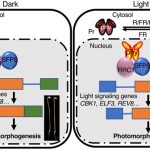Plant Science Research Weekly: October 11
 This week’s Plant Science Research Weekly is guest edited by Arif Ashraf. He is a postdoc at Facette lab in the University of Massachusetts Amherst and his research focus is deciphering the asymmetric cell division during stomatal development. He is working as an ASPB ambassador, Plantae Fellow, Co-founder of Plant Postdoc Slack and science writer (www.aribidopsis.com). Find Arif on twitter @aribidopsis
This week’s Plant Science Research Weekly is guest edited by Arif Ashraf. He is a postdoc at Facette lab in the University of Massachusetts Amherst and his research focus is deciphering the asymmetric cell division during stomatal development. He is working as an ASPB ambassador, Plantae Fellow, Co-founder of Plant Postdoc Slack and science writer (www.aribidopsis.com). Find Arif on twitter @aribidopsis
The bracteatus pineapple genome and domestication of clonally propagated crops (OA) (Nature Genetics)
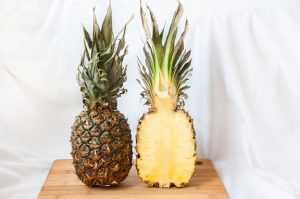 You probably know well the sweet and yellow “smooth cayenne” pineapple (Ananas comosus). This fruit was domesticated a few millennia ago in South America. Pineapple domestication targeted fiber production, color, and sugar accumulation. How it happened remained mysterious. To resolve this mystery, Chen et al. resequenced 89 accessions of these clonal plants. They found a domestication history a bit more complex than expected. They did find the signature of a severe domestication bottleneck. But they also found evidence of ancient and recent admixture. Sexual recombination did play a role in generating the diversity of the pineapples. Then, human interventions played with that diversity to get to the fruit that we know now. To finish this recipe, let’s add some somatic mutations and abundant transposable elements. Enjoy, your pineapple is ready. (Summary by Celine Caseys) Nature Genetics: 10.1038/s41588-019-0506-8
You probably know well the sweet and yellow “smooth cayenne” pineapple (Ananas comosus). This fruit was domesticated a few millennia ago in South America. Pineapple domestication targeted fiber production, color, and sugar accumulation. How it happened remained mysterious. To resolve this mystery, Chen et al. resequenced 89 accessions of these clonal plants. They found a domestication history a bit more complex than expected. They did find the signature of a severe domestication bottleneck. But they also found evidence of ancient and recent admixture. Sexual recombination did play a role in generating the diversity of the pineapples. Then, human interventions played with that diversity to get to the fruit that we know now. To finish this recipe, let’s add some somatic mutations and abundant transposable elements. Enjoy, your pineapple is ready. (Summary by Celine Caseys) Nature Genetics: 10.1038/s41588-019-0506-8
Ongoing accumulation of plant diversity through habitat connectivity in an 18-year experiment ($) (Science)
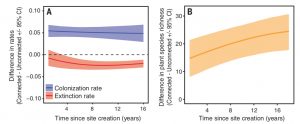 During the course of time, we have realized the importance of biodiversity for the maintenance of the ecosystem. However, the world has already been fragmented in small parts which resulted in a huge loss of habitat and threatening to biodiversity. Habitat connectivity, which refers to the degree that separated patches of habitat are connected, is considered to be one of the most important factors in maintaining diversity. A recent publication by Damschen et. al, has tested long term effects of habitat connectivity on plant colonization and extinction dynamics for almost over two decades in a habitat fragmentation experiment. They created connected and non-connected habitat fragments and censused the occupancy of all plant species assembled after the restoration of fragments over the years. They observed the habitat connectivity increased the species colonization by 5% and reduced the extinction rate by 2%. By using corridors to connect the fragmented habitats they have shown the drastic and long term effect on maintaining diversity and ecological conservation. (Summary by Mugdha Sabale) Science: 10.1126/science.aax8992
During the course of time, we have realized the importance of biodiversity for the maintenance of the ecosystem. However, the world has already been fragmented in small parts which resulted in a huge loss of habitat and threatening to biodiversity. Habitat connectivity, which refers to the degree that separated patches of habitat are connected, is considered to be one of the most important factors in maintaining diversity. A recent publication by Damschen et. al, has tested long term effects of habitat connectivity on plant colonization and extinction dynamics for almost over two decades in a habitat fragmentation experiment. They created connected and non-connected habitat fragments and censused the occupancy of all plant species assembled after the restoration of fragments over the years. They observed the habitat connectivity increased the species colonization by 5% and reduced the extinction rate by 2%. By using corridors to connect the fragmented habitats they have shown the drastic and long term effect on maintaining diversity and ecological conservation. (Summary by Mugdha Sabale) Science: 10.1126/science.aax8992
Auronidins are a previously unreported class of flavonoid pigments that challenge anthocyanin biosynthesis evolved in plants (OA) (PNAS)
 Plants produce pigments as a protective strategy against biotic and abiotic stress. In angiosperms, anthocyanins are the main flavonoids that play this role. Since the early-diverging land plant, Marchantia polymorpha also produces red pigments in response to environmental conditions, it was thought that anthocyanin biosynthesis was conserved, although the pigment that accumulates in Marchantia is structurally different from anthocyanins. Using RNA-seq analysis over myb14 mutant deficient in auronidn production, Berland et al. identified key enzymes involved in the biosynthesis of these compounds in Marchantia. Knocking down these genes, they found that these particular flavonoids are produced by a different biosynthetic pathway compared to anthocyanins. These compounds also possess different chemical properties and correspond to a novel class of flavonoid, renamed here as Auronidins. This paper questions the evolutionary origin of anthocyanin biosynthesis, placing it later in the divergence of seed plants. At the same time, both embryophyte groups seem to have developed similar systems to protect themselves against stress with flavonoids but using different molecular pathways. This shows how complex and fascinating the evolution of plants could be. Future works will shed more light on the evolution of plant pigments. (Summary by Facundo Romani) PNAS: 10.1073/pnas.1912741116
Plants produce pigments as a protective strategy against biotic and abiotic stress. In angiosperms, anthocyanins are the main flavonoids that play this role. Since the early-diverging land plant, Marchantia polymorpha also produces red pigments in response to environmental conditions, it was thought that anthocyanin biosynthesis was conserved, although the pigment that accumulates in Marchantia is structurally different from anthocyanins. Using RNA-seq analysis over myb14 mutant deficient in auronidn production, Berland et al. identified key enzymes involved in the biosynthesis of these compounds in Marchantia. Knocking down these genes, they found that these particular flavonoids are produced by a different biosynthetic pathway compared to anthocyanins. These compounds also possess different chemical properties and correspond to a novel class of flavonoid, renamed here as Auronidins. This paper questions the evolutionary origin of anthocyanin biosynthesis, placing it later in the divergence of seed plants. At the same time, both embryophyte groups seem to have developed similar systems to protect themselves against stress with flavonoids but using different molecular pathways. This shows how complex and fascinating the evolution of plants could be. Future works will shed more light on the evolution of plant pigments. (Summary by Facundo Romani) PNAS: 10.1073/pnas.1912741116
CRISPR-TSKO: A technique for efficient mutagenesis in specific cell types, tissues, or organs in Arabidopsis ($) (Plant Cell)
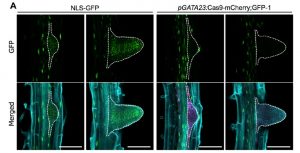 The ability to introduce base-specific changes through CRISPR/Cas9 gene editing has given scientists fantastic tools with which to understand and modify the genes that control plant development and physiology. New tools and refinements to this toolkit are being developed rapidly. In this new work, Decaestecker et al. introduce CRISPR-TSKO (tissue-specific knockout system). The power of this new method is that gene editing can occur in a very limited subset of cells or tissues, which is invaluable when studying genes that might be lethal when knocked out in all tissues (about 10% of Arabidopsis genes are indispensable). The tissue specificity is conferred by expressing Cas9 nuclease from tissue-specific promoters. The authors started by knocking out GFP as a proof-of-concept and then expanded to test several known regulatory genes. Constructs are available from the authors or Addgene, and detailed cloning protocols are provided. (Summary by Mary Williams) Plant Cell 10.1105/tpc.19.00454
The ability to introduce base-specific changes through CRISPR/Cas9 gene editing has given scientists fantastic tools with which to understand and modify the genes that control plant development and physiology. New tools and refinements to this toolkit are being developed rapidly. In this new work, Decaestecker et al. introduce CRISPR-TSKO (tissue-specific knockout system). The power of this new method is that gene editing can occur in a very limited subset of cells or tissues, which is invaluable when studying genes that might be lethal when knocked out in all tissues (about 10% of Arabidopsis genes are indispensable). The tissue specificity is conferred by expressing Cas9 nuclease from tissue-specific promoters. The authors started by knocking out GFP as a proof-of-concept and then expanded to test several known regulatory genes. Constructs are available from the authors or Addgene, and detailed cloning protocols are provided. (Summary by Mary Williams) Plant Cell 10.1105/tpc.19.00454
Insect herbivory selects for volatile-mediated plant-plant communication ($) (Current Biology)
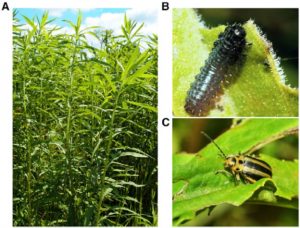 Plants release volatile organic compounds (VOCs) in response to insect herbivory. The potential for VOCs to serve as diffusible signals has long been recognized. For example, VOCs can signal neighbors to prime for defense, signal distant parts of the emitting plant, and even attract predatory insects to help defend the plant. How do VOCs affect plant fitness, and how does predation select for VOC production or response? Kalske et al. investigated these questions by testing the effect of VOC emissions on neighboring plants when the receiving plants were from a population that had either been or not been subject to herbivory for the past 12 years. Plants exposed to herbivory were responsive to emitter plants whether or not they were genetically identical, whereas those that hadn’t had pressure from herbivores were more restricted in their responses. Furthermore, the blend of VOCs produced was more similar in the populations that had been exposed to herbivory. This study shows that herbivory drives the evolution of plant-plant communication, favoring an open-channel model, and also that plants can be good models for the study of the evolution of communication. (Summary by Mary Williams) Curr. Biol. 10.1016/j.cub.2019.08.011
Plants release volatile organic compounds (VOCs) in response to insect herbivory. The potential for VOCs to serve as diffusible signals has long been recognized. For example, VOCs can signal neighbors to prime for defense, signal distant parts of the emitting plant, and even attract predatory insects to help defend the plant. How do VOCs affect plant fitness, and how does predation select for VOC production or response? Kalske et al. investigated these questions by testing the effect of VOC emissions on neighboring plants when the receiving plants were from a population that had either been or not been subject to herbivory for the past 12 years. Plants exposed to herbivory were responsive to emitter plants whether or not they were genetically identical, whereas those that hadn’t had pressure from herbivores were more restricted in their responses. Furthermore, the blend of VOCs produced was more similar in the populations that had been exposed to herbivory. This study shows that herbivory drives the evolution of plant-plant communication, favoring an open-channel model, and also that plants can be good models for the study of the evolution of communication. (Summary by Mary Williams) Curr. Biol. 10.1016/j.cub.2019.08.011
Genome editing retraces the evolution of toxin resistance in the monarch butterfly ($) (Nature)
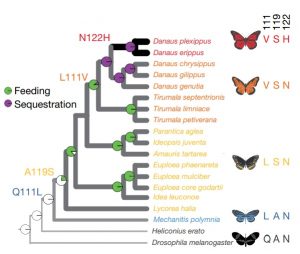 When a few species from several distantly related groups produce a similar but unusual trait, we usually assume that this trait is an example of convergent evolution; starting from different places but ending up at the same place. The ability to eat plants that produce cardiac glycosides, which are toxic to most animals, occurs in a few species from across six insect orders, so is considered an example of convergent evolution. Thanks to genome sequencing and the ability to edit genomes through CRISPR/Cas9, it is now possible to directly test these assumptions. Karageorgi et al. have done that, by identifying key substitutions in ATPα that occur in multiple resistant species, and also determining the apparent order in which they arose. The authors then introduced these substitutions into Drosophila and found as the increased the number of candidate substitutions, resistance to ouabain (a cardiac glycoside) increased. The authors conclude that this is “the first in vivo validation of a multi-step adaptive walk in a multicellular organism.” (Summary by Mary Williams) Nature 10.1038/s41586-019-1610-8
When a few species from several distantly related groups produce a similar but unusual trait, we usually assume that this trait is an example of convergent evolution; starting from different places but ending up at the same place. The ability to eat plants that produce cardiac glycosides, which are toxic to most animals, occurs in a few species from across six insect orders, so is considered an example of convergent evolution. Thanks to genome sequencing and the ability to edit genomes through CRISPR/Cas9, it is now possible to directly test these assumptions. Karageorgi et al. have done that, by identifying key substitutions in ATPα that occur in multiple resistant species, and also determining the apparent order in which they arose. The authors then introduced these substitutions into Drosophila and found as the increased the number of candidate substitutions, resistance to ouabain (a cardiac glycoside) increased. The authors conclude that this is “the first in vivo validation of a multi-step adaptive walk in a multicellular organism.” (Summary by Mary Williams) Nature 10.1038/s41586-019-1610-8
Coordinated regulation of pre-mRNA splicing by the SFPS-RRC1 complex to promote photomorphogenesis ($) (Plant Cell)
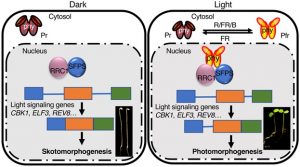 Phytochromes are a family of red/far-red light photoreceptors, which positively regulate photomorphogenesis upon red-light perception. Photomorphogenesis is driven by light-induced global transcriptional reprogramming, of which phytochromes are one of the most important regulators. In addition to transcriptional regulation, recent experimental evidence suggests that phytochromes also regulate pre-mRNA splicing of a large number of genes, and at least one of the splicing factors, SFPS (Splicing Factor for Phytochrome Signaling), is shown to interact with phytochromes and coordinately modulate pre-mRNA splicing. In this paper, Xin et al. have identified one more splicing factor RRC1 (Reduced Red-light responses in cry1cry2 background 1) as one of the interacting proteins of SFPS and phyB. Through RNA- seq analysis authors showed that RRC1 regulates the expression and pre-mRNA splicing of a large number of genes, both under dark and red- light treatment. Moreover, they also found that RRC1 and SFPS together co-regulate hundreds of splicing events, suggesting they might function, in part, in the same complex and pathway. Finally, they conclude that phytochromes modulate the pre-mRNA splicing by directly interacting with splicing factors and (probably) regulating their activity in response to red-light irradiation. Overall, this paper provides a comprehensive view of yet another novel molecular mechanism of phytochrome- mediated signaling to promote photomorphogenesis in Arabidopsis. (Summary by Ruijiao Xin) Plant Cell: 10.1105/tpc.18.00786
Phytochromes are a family of red/far-red light photoreceptors, which positively regulate photomorphogenesis upon red-light perception. Photomorphogenesis is driven by light-induced global transcriptional reprogramming, of which phytochromes are one of the most important regulators. In addition to transcriptional regulation, recent experimental evidence suggests that phytochromes also regulate pre-mRNA splicing of a large number of genes, and at least one of the splicing factors, SFPS (Splicing Factor for Phytochrome Signaling), is shown to interact with phytochromes and coordinately modulate pre-mRNA splicing. In this paper, Xin et al. have identified one more splicing factor RRC1 (Reduced Red-light responses in cry1cry2 background 1) as one of the interacting proteins of SFPS and phyB. Through RNA- seq analysis authors showed that RRC1 regulates the expression and pre-mRNA splicing of a large number of genes, both under dark and red- light treatment. Moreover, they also found that RRC1 and SFPS together co-regulate hundreds of splicing events, suggesting they might function, in part, in the same complex and pathway. Finally, they conclude that phytochromes modulate the pre-mRNA splicing by directly interacting with splicing factors and (probably) regulating their activity in response to red-light irradiation. Overall, this paper provides a comprehensive view of yet another novel molecular mechanism of phytochrome- mediated signaling to promote photomorphogenesis in Arabidopsis. (Summary by Ruijiao Xin) Plant Cell: 10.1105/tpc.18.00786
A phyB-PIF1-SPA1 kinase regulatory complex promotes photomorphogenesis in Arabidopsis (OA) (Nature Communications)
 CONSTITUTIVE PHOTOMORPHOGENIC 1 (COP1) is one of the best characterized E3 ubiquitin ligases with broad roles as a central repressor of light signaling in plants to cancer biology in mammals. In plants, COP1 interacts with SUPPRESSOR OF PHYA-105 1 family members (SPA1-SPA4) and forms a stable COP1/SPA complex. This story provides evidence that SPA1, a component of the COP1-SPA E3 ubiquitin ligase complex, itself can act as a protein kinase. By performing extensive biochemical, genetic and genomic analyses, they provide strong evidence that SPA1 is a bona fide Serine/Threonine kinase that is necessary for the light-induced phosphorylation and degradation of PIF1. They also provide mechanistic details on how the red/far-red light photoreceptor phytochrome B directly interacts with SPA1 kinase in response to red light, and this interaction plays a pivotal role in inducing PIF1 phosphorylation and subsequent degradation to promote seed germination and seedling development. This is a ground-breaking work discovering a novel kinase that might serve as a model for other kinase-E3 ubiquitin ligase complexes (e.g., mammalian COP1-Trib kinase complex) and help decipher new intriguing roles of COP1 and associated kinases from other systems. (Summary by Inyup Paik) Nature Communications: 10.1038/s41467-019-12110-y
CONSTITUTIVE PHOTOMORPHOGENIC 1 (COP1) is one of the best characterized E3 ubiquitin ligases with broad roles as a central repressor of light signaling in plants to cancer biology in mammals. In plants, COP1 interacts with SUPPRESSOR OF PHYA-105 1 family members (SPA1-SPA4) and forms a stable COP1/SPA complex. This story provides evidence that SPA1, a component of the COP1-SPA E3 ubiquitin ligase complex, itself can act as a protein kinase. By performing extensive biochemical, genetic and genomic analyses, they provide strong evidence that SPA1 is a bona fide Serine/Threonine kinase that is necessary for the light-induced phosphorylation and degradation of PIF1. They also provide mechanistic details on how the red/far-red light photoreceptor phytochrome B directly interacts with SPA1 kinase in response to red light, and this interaction plays a pivotal role in inducing PIF1 phosphorylation and subsequent degradation to promote seed germination and seedling development. This is a ground-breaking work discovering a novel kinase that might serve as a model for other kinase-E3 ubiquitin ligase complexes (e.g., mammalian COP1-Trib kinase complex) and help decipher new intriguing roles of COP1 and associated kinases from other systems. (Summary by Inyup Paik) Nature Communications: 10.1038/s41467-019-12110-y
BZU2/ZmMUTE controls symmetrical division of guard mother cell and specifies neighbor cell fate in maize (OA) (PLOS Genetics)
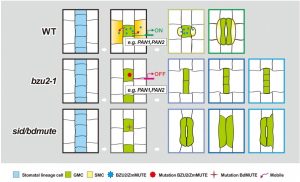 Stomatal development has been studied thoroughly in the dicot model plant Arabidopsis thaliana, but stomatal development fundamentally differs between dicot and monocot formation of subsidiary cells, a pair of dumbell-shaped cells adjacent to the guard cell. In this study, Wang et al., identified an EMS mutation, bzu2-1, in maize which lacks subsidiary cells and normal guard cells. Interestingly, they have found that ZmBZU2 is a basic helix-loop-helix (bHLH) transcription factor and an ortholog of AtMUTE in Arabidopsis. Subsidiary mother cells go through asymmetric cell division for subsidiary cell formation and they have observed the absence of SMC polarization in bzu2-1. Additionally, the authors have demonstrated that ZmBZU2 moves from guard mother cell to subsidiary mother cell and regulates the expression of guard cell formation and subsidiary cell precursor initiation related genes. This work presented the role of ZmBZU2 for subsidiary mother cell polarization and the formation of guard cells in maize. (Summary by Arif Ashraf) PLOS Genetics: 10.1371/journal.pgen.1008377
Stomatal development has been studied thoroughly in the dicot model plant Arabidopsis thaliana, but stomatal development fundamentally differs between dicot and monocot formation of subsidiary cells, a pair of dumbell-shaped cells adjacent to the guard cell. In this study, Wang et al., identified an EMS mutation, bzu2-1, in maize which lacks subsidiary cells and normal guard cells. Interestingly, they have found that ZmBZU2 is a basic helix-loop-helix (bHLH) transcription factor and an ortholog of AtMUTE in Arabidopsis. Subsidiary mother cells go through asymmetric cell division for subsidiary cell formation and they have observed the absence of SMC polarization in bzu2-1. Additionally, the authors have demonstrated that ZmBZU2 moves from guard mother cell to subsidiary mother cell and regulates the expression of guard cell formation and subsidiary cell precursor initiation related genes. This work presented the role of ZmBZU2 for subsidiary mother cell polarization and the formation of guard cells in maize. (Summary by Arif Ashraf) PLOS Genetics: 10.1371/journal.pgen.1008377


